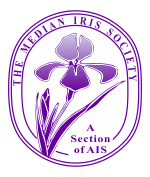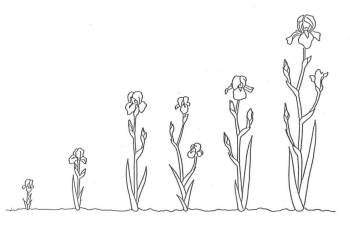

Median Iris Glossary
| Abbreviations for different types of Irises: | |||||

|
|||||
| MDB | SDB | IB | MTB | BB | TB |
Iris Classifications
| Abbr. | Definition |
|---|---|
| Median | All bearded iris classes (SDBs, IBs, BBs, and MTBs) between 8 and 27.5 inches. |
| MDB | Miniature Dwarf Bearded, up to 8" tall, generally the first beardeds to bloom in earliest spring. |
| SDB | Standard Dwarf Bearded, 8 - 16" tall, bloom in early spring. |
| IB | Intermediate Bearded, 16 - 27.5" tall, generally bloom after SDBs and before TBs. |
| MTB | Miniature Tall Bearded, 16 - 27.5" tall, branched, with flowers no more than 6" combined width + height, generally bloom with the TBs. |
| BB | Border Bearded, 16 - 27.5" tall, generally bloom with the TBs. |
| TB | Tall Bearded, more than 27.5" tall, bloom in mid to late spring. |
| AR | Aril iris: refers to Oncocyclus and Regelia species, and hybrids involving only these two groups. |
| AB | Arilbred iris: refers to hybrids between the Aril (AR) and other bearded (Eupogon) irises, containing one-quarter or more Aril complement and exhibiting at least two Aril flower characteristics. |
| ABM | Arilbred Median, any Arilbred of one-half Aril complement or less, with a registered height between 13 and 22 inches (33 and 56 cm), inclusive. |
| RE | varieties that produce more than one crop of bloom stalks in a single growing season. |
| HIS | Historic Iris cultivars are any iris introduced over 30 years ago. |
Parts of an Iris Flower
| Part | Definition |
|---|---|
| Standards (S) | The upturned three petals, (technically called sepals) that surround the three style arms. |
| Falls (F) | The downturned three petals, (correctly called petals) that possess beards. These may also be horizontally flared or flat instead of downturned). |
| Beards (B) | Elongate groups of fuzzy hairs in the middle at the upper base of all three falls. |
| Space Age (SA) | Iris have something extra, beard appendages called horns, spoons or flounces. |
| Spoons | Appendages extending from the tip of the beards that widen into spoon shaped petaloids. |
| Horns | A protrusion or extension of the beards, often ending in a point or may be hair covered. |
| Flounces | Wide, folded, often canoe or fan shaped appendages extending from the tips of the beards. |
| Hafts | Areas on each side of the narrow of the falls, on each side of the beards. |
| Shoulders | The areas on the arching upper middle part of the falls on each side just beyond the haft areas. |
| Pistil | The style arms with stigmatic lips and the ovary. The female flower parts. |
| Claw | The narrow base of the standard and fall, the expanded leaf-like part is called the blade. |
| Ovary | The enlarged green, three-chambered structure enclosing the ovules where fertilization occurs. |
| Spathes | The pair of modified green leaves that enclose the flower bud, usually turning tan after it blooms. |
| Stamen | The anther plus its attachment filament. The anthers contain the granular pollen. The male flower parts. |
| Rhizome | Brownish, potato-looking, fleshy root. |
Season of Bloom
| VE = Very Early | E = Early | M = Midseason | L = Late | VL = Very Late |
Descriptive Terms
| Term | Definition |
|---|---|
| Self | Standards, style arms and falls are the same color, as a complete self they have the same color beards. |
| Amoena | White standards and anthocyanin pigmented falls. |
| Reverse Amoena | Anthocyanin pigmented standards and white falls. |
| Emma Cook pattern | An amoena pattern with white standards and narrow anthocyanin pigmentation bordered falls. |
| Bicolor | Standards are a different color than the falls. |
| Bitone | Standards are a lighter shade of color than the falls. |
| Neglecta | Blue or purple bitones with standards a lighter shade of the color of the falls. |
| Reverse bitone | A bitone with the standards a darker shade of the same color as the lighter falls. |
| Blend | Combination of two or more colors, can be smoothly or unevenly mixed. |
| Variegata | Yellow standards and maroon or brown falls. |
| Plicata | Stippled, dotted, or stitched margins of anthocyanin pigmentation on lighter ground color. |
| Luminata | The reverse pattern of a plicata, with darker ground color and white edges, veins and around beards. |
| Glaciata | These lack all anthocyanin pigments and are pure whites, yellows, pinks, or oranges, formerly called ices. |
| Substance | Thickness and resilient tensile strength of the flower parts. |
| Texture | Surface sheen or finish, such as velvety or satiny finish of the petals. |
| Diamond dusted | Tiny, conical raised areas across the petal surface that shine like diamonds in the light. |
| Silver lining | Standards and falls have raised areas on the edges that reflects light in a shining light. |
| Wash | Obvious or definite overlay of one color on another. |
| Infusion | Faint or subtle overlay of one color on another. |
| Sunburst | White or light streaks fanning out on the falls around, and sometimes beyond, the beards. |
| Spot | Darker area around and below the beard on lighter or different colored falls. |
| Signal | An area or patch of contrasting color below the beards (usually on arils, and some beardless varieties). |
| Zonal | A distinct white or light area around the beards in the middle of the falls. |